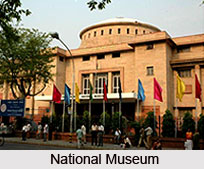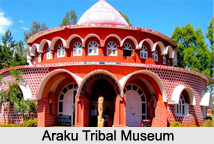 India is a land with a history and culture that goes back over 5000 years. Innumerable historical sites, cities and monuments across the length and breadth of the country are a testimony to this rich cultural past. India`s museums offer visitors a rare opportunity to observe over five millennium of concentrated culture under a single roof. The National Museum is one of India`s most prominent institutions. The Indus Valley gallery displays many antiquities discovered from Mohenjodaro and Harappa, like terracotta toys, images and pots, jewellery, seals, bronze and copper implements and sculptures.
India is a land with a history and culture that goes back over 5000 years. Innumerable historical sites, cities and monuments across the length and breadth of the country are a testimony to this rich cultural past. India`s museums offer visitors a rare opportunity to observe over five millennium of concentrated culture under a single roof. The National Museum is one of India`s most prominent institutions. The Indus Valley gallery displays many antiquities discovered from Mohenjodaro and Harappa, like terracotta toys, images and pots, jewellery, seals, bronze and copper implements and sculptures.
As this museum is situated in the historic Red Fort, it displays objects of the Mughal period such as manuscripts and firmans, which exhibit the ine art of calligraphy, paintings, textiles and costumes. There is also a section, which concentrates on relics of the 1857 war (First War of Independence) like maps and weapons. The National Museum is located on Janpath, south of Rajpath, covering an excellent collection of bronzes, terracotta sculptures, paintings and costumes, which give a complete insight into Indian history and way of life. The collection consists of rare coins and pottery dating back to the Mauryan period 2nd-3rd century BC, exhibits from the Vijayanagar period in south India, miniature and wall paintings, and costumes of the various tribal people.
It also has the largest collection of artifacts dating to the Indus Valley Civilization. The museum is absolutely worth visiting.  The museum has a rich variety of all facts of ancient Indian history and also of central Asia. The museum takes through a fascinating trip of what ancient India was all about, pottery, rare coins, and numerous such things including art and architecture, costumes. It`s something every tourist should find time to visit even if the schedule is tight.
The museum has a rich variety of all facts of ancient Indian history and also of central Asia. The museum takes through a fascinating trip of what ancient India was all about, pottery, rare coins, and numerous such things including art and architecture, costumes. It`s something every tourist should find time to visit even if the schedule is tight.
The most outstanding object here is the lyrical bronze Dancing Girl. The Bronze Gallery has some superb pieces from the Chola and Pallava period. Among these the Nataraja figure of Shiva and the Kaliya Mardan Krishna are all time greats. There are a number of rare manuscripts and miniature paintings, textiles, coins and tribal art. However, the museum`s most significant gallery is the one of Central Asian exhibits. Silk banners from Dunhuang, wall paintings, sculpture and other objects collected by Sir Aurel Stein capture the lifestyle and culture prevalent along the ancient Silk Route that stretched between Europe and China. The color paintings of Moghul, Rajput, and Deccan are praiseworthy. Besides, there are the holy Git Gobinda, the holy Mahabharata, the holy Bhagvat Gita in golden alphabet, Octogonal mini Quran, Babamama in Babar`s handwriting, Jahangir`s diary, musical instruments of more than 300 types, varieties of tribal dresses enriched the museum. The antique collections of Sir Aurel Stein have added to the attraction of the museum.
The blue print for establishing the National Museum in Delhi had been prepared by the Gwyer Committee set up by the Government of India in 1946. When an Exhibition of Indian Art consisting of chosen artifacts from various museums of India, sponsored by the Royal Academy (London) with the co-operation of the Government of India and Britain, was on exhibit in the galleries of Burlington House, London during the winter months of 1947-48, it was decided to display the same collection under a single roof in Delhi before the return of exhibits to their respective museums. Accordingly, the exibition was held in the staterooms of the Rashtrapati Bhawan, New Delhi in 1949, and it turned out to be a great success.  In turn, the event proved responsible for the creation of National Museum. On the auspicious day of the 15th August, 1949, the National Museum was formally inaugurated by the Governor General of India, Shri R.C. Rajagopalachari, and it was announced that till a permanent building for housing the National Musuem was constructed, the Museum would continue to function in the Rashtrapati Bhawan.
In turn, the event proved responsible for the creation of National Museum. On the auspicious day of the 15th August, 1949, the National Museum was formally inaugurated by the Governor General of India, Shri R.C. Rajagopalachari, and it was announced that till a permanent building for housing the National Musuem was constructed, the Museum would continue to function in the Rashtrapati Bhawan.
The Government also felt to keep the exhibits on show to form the assets of the National Museum and the plan was sent to all the participants of London exhibition. It continued to be looked after well by the Director General of Archaeology until the Ministry of Education, the Government of India declared it a separate institution to grow in its collections that were sought carefully. It received several gifts but artefacts were collected mainly through its Art Purchase Committee. In the meanwhile, the foundation of the present building was laid by Pt. J.L. Nehru, Prime Minister of India, in the 12th May, 1955 and the new building where works of art were displayed elegantly on scientific lines, was handed over to Museum authorities in June, 1960.
The Museum was formally thrown open to the public on December 18, 1960. And it is now within the administrative control and fully financed by the Department of Culture, Ministry of Human Resource Development, and Government of India. The Museum has in its custody approximately 2,00,000 works of beautiful art of diverse nature, both Indian and foreign and its assets cover a time span of more than five thousand years of our cultural tradition. While the marvelous chronological show of selected art objects in the various galleries, screening of educational films related to art and culture, guided tours, gallery talks by the experts, special lectures and training programmes, facilities for photography and access to the reserve collection and library for the study, and advice on identification of art objects have brought huge success to the Museum.
 Collections
Collections
The Archaeological Survey of India and the National Museum jointly set up the Harappan gallery. It has a rich collection of a large number of artifacts from the sites of Harappan Civilisation. The collection includes pottery, seals, tablets, weights and measures, jewellery, terracotta figurines, toys, etc. It also has copper tools from Harappan sites like axes, chisels, knives, etc. About 3,800 objects have been displayed in the modernised Harappan Gallery from the National Museum collection. This Gallery also has 1,025 excavated artifacts belonging to the Indian Harappan site of the Archaeological Survey of India collection.
Archaeology
A prestigious collection of approximately 800 sculptures have been displayed in theArchaeological Galleries on the ground floor, the rotundas on the ground, first and second floors and around the museum building. The sculptures displayed are mostly in stone, bronze and terracotta, dating from the 3rd century B.C., through the 19th century A.D. representing all major regions, periods and schools of art. National Museum, New Delhi, today, has in its ownership over 2,00,000 works of fine art, both of Indian and Foreign origin covering more than 5,000 years of our cultural heritage. Its rich wealth of various creative traditions and disciplines, which represents a unity in diversity, a matchless blend of the past with the present and strong point of view for the future, brings history to life.  Apart from the collections of Pre-historic Archaeology, Archaeology, Jewellery, Paintings, Decorative arts, Manuscripts, Central Asian Antiquities, Arms and Armour, etc the Museum today has a separate branches of publication, Hindi, Public Relations, Education, Library, Exhibition cell, Display, Modelling, Photography, Security and Administration.
Apart from the collections of Pre-historic Archaeology, Archaeology, Jewellery, Paintings, Decorative arts, Manuscripts, Central Asian Antiquities, Arms and Armour, etc the Museum today has a separate branches of publication, Hindi, Public Relations, Education, Library, Exhibition cell, Display, Modelling, Photography, Security and Administration.
Arts Collections
The Archaeological Survey of India and the National Museum mutually set up the National Museum of Delhi. It has a rich collection of a large number of artifacts from the sites of Harappan Civilisation. The collection includes pottery, seals, tablets, weights and measures, jewellery, terracotta figurines, toys, etc. It also has copper tools from Harappan sites like axes, chisels, knives, etc. About 3,800 objects have been displayed in the modernised Harappan Gallery from the National Museum collection. This Gallery also has 1,025 excavated artifacts belonging to the Indian Harappan site of the Archaeological Survey of India collection. The gallery brings to light for the first time 232 special decorative artifacts, which are dated from 18th-20th century. All these useful and decorative objects are made with different material, like ivory, jade, glass, wood, marble, metal and ceramic. In the gallery, 26 large sized well-lit glass transparencies are on show displaying the amazing story of the development of various Indian scripts from Brahmi and coins. The National Museum has a wide Reference Library, which is equipped with variety of books, Periodicals, Journals etc.













